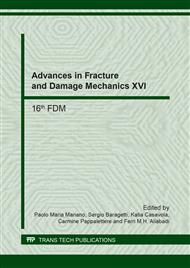p.309
p.313
p.317
p.321
p.325
p.329
p.333
p.337
p.341
Performance of Anchors in Concrete Controlled by Splitting Failure under Dynamic Push-In Loadings
Abstract:
Anchors in concrete are widely used to transfer any given load combination into a concrete member. The dynamic behavior of post-installed rebar anchors has been experimentally investigated in this study. The attention was focused on anchors controlled by concrete splitting failure, the case that may occur with anchors and fastenings located close to an edge or to a corner. In this regard, Split Hopkinson Pressure Bar (SHPB) technique has been employed to test the anchorage systems under dynamic push-in loads. The effect of loading rates, concrete compressive strengths, and embedment depths on ultimate splitting load has been studied. The results showed the loading rates had a pronounced effect on the anchor ultimate loads and total absorbed energy by the anchors. Whereas the variation of concrete compressive strength influenced the ultimate load, the increase in embedment depth had no noticeable effect on ultimate load.
Info:
Periodical:
Pages:
325-328
Citation:
Online since:
September 2017
Authors:
Price:
Сopyright:
© 2017 Trans Tech Publications Ltd. All Rights Reserved
Share:
Citation:


